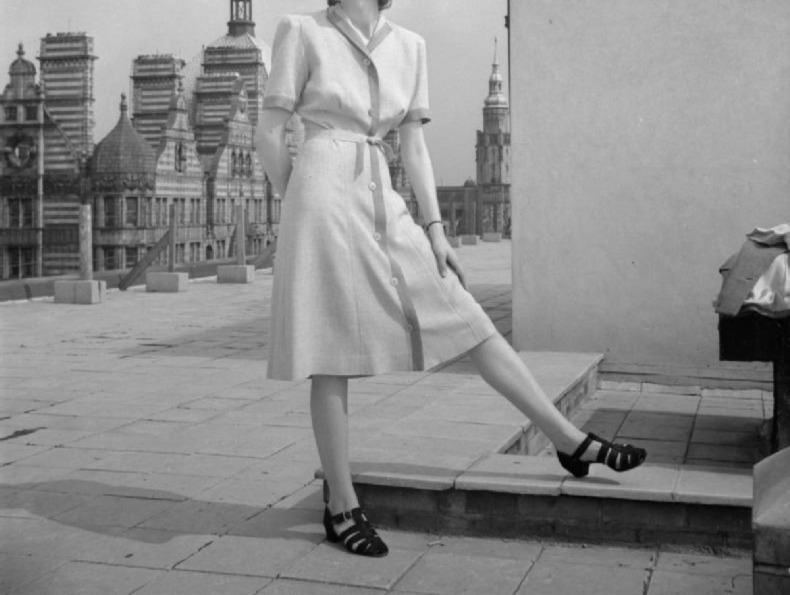Women’s Fashion in the 1940s was defined by a blend of practicality and elegance, heavily influenced by World War II. The decade saw significant changes in how women dressed, with rationing playing a significant role in shaping the styles. Despite the limitations, women of the 1940s found ways to remain stylish, creating looks that were functional yet feminine.
Utility Clothing and Wartime Fashion
The war directly impacted Fashion in the early 1940s. With materials like wool, silk, and nylon being rationed, women’s clothing became more straightforward and more efficient. Utility clothing was introduced in the UK, with garments that were practical and used minimal fabric. Dresses were often knee-length, and skirts were straight or slightly flared to save fabric. While the designs were plain, women often accessorized with hats, belts, and scarves to add a personal touch.
The Signature Victory Suit
One of the most iconic looks for women during the 1940s was the Victory Suit. This outfit was tailored and professional, consisting of a matching jacket and skirt. The jackets often had padded shoulders, giving a robust and structured silhouette. Women wore these suits for work and formal occasions, as they were versatile and could be paired with different blouses. The Victory Suit became a symbol of the working woman during wartime.
1940s Evening Wear
While the daywear was practical, 1940s evening Fashion remained glamorous. Women attending formal events wore long, flowing gowns made from luxurious materials like satin or silk (when available). These dresses featured elegant details such as draped necklines, fitted waists, and long skirts. Evening looks were often completed with accessories like gloves, fur wraps, and sparkling jewelry, giving a sense of luxury despite wartime shortages.
Make Do and Mend: Creative Fashion Solutions
Due to fabric shortages, women were encouraged to “make do and mend.” This meant repurposing old garments into new outfits and repairing damaged clothing rather than buying new ones. Dresses were often shortened or altered, and creative solutions were used to keep wardrobes fresh. For example, old curtains or upholstery fabric might be turned into new dresses, and scraps of material were used to patch or embellish outfits.
The Role of Trousers
Trousers became an essential part of women’s wardrobes in the 1940s, especially for those working in factories or performing jobs previously held by men. High-waisted, wide-legged trousers provided both comfort and functionality. Paired with a tucked-in blouse or a knitted sweater, this look became a staple for working women. Although trousers were initially considered unconventional for women, they gained acceptance during the war and became a symbol of women’s growing independence.
Hairstyles and Accessories
Accessories played a crucial role in 1940s Fashion, allowing women to add flair to their otherwise simple outfits. Hats were trendy, with tiny, tilt hats and wide-brimmed styles often adorned with feathers or veils. Headscarves also became a standard accessory, particularly for women working in factories, as they helped keep hair neatly tucked away.
The 1940s hairstyles were typically short to medium in length, with waves and curls being the most popular styles. Victory rolls, where sections of hair were rolled and pinned to the top of the head, became an iconic look of the era. This hairstyle was practical for working women but also gave a glamorous touch to everyday outfits.
Footwear in the 1940s
Due to material shortages, leather shoes became scarce during the war. As a result, women’s shoes were often made from alternative materials like wood or cork. Wedge shoes and platform heels were trendy, offering comfort and height without using too much leather. Practical styles like loafers and Oxfords were worn during the day, while more glamorous heels were reserved for evening wear.
Hollywood’s Influence on 1940s Fashion
Even during the war, Hollywood remained a significant influence on women’s Fashion. Actresses like Rita Hayworth, Lauren Bacall, and Katharine Hepburn set the trends for both casual and formal styles. Movies offered an escape from the grim realities of war, and women admired the glamorous looks worn by their favorite stars. Many tried to replicate these styles at home, even if they had to make do with more affordable fabrics.
Post-War Fashion: The New Look
After the war ended in 1945, women’s Fashion dramatically changed. The post-war years saw a return to more luxurious, feminine designs, symbolizing a new era of optimism. Christian Dior’s “New Look” debuted in 1947, with its cinched waists, full skirts, and emphasis on femininity. This new style was a departure from practical wartime clothing and marked the beginning of a more glamorous, elegant era in women’s Fashion.
Popular Fabrics and Patterns
During the war, limited fabric choices were rationed, so cotton and rayon were commonly used for everyday wear. These fabrics were easy to produce and maintain, making them practical for the average woman. Floral patterns, polka dots, and stripes were popular prints, adding a cheerful touch to otherwise simple designs. After the war, silk, satin, and lace returned to popularity for more formal occasions.
Influence of the Military
The military had a noticeable influence on women’s Fashion in the 1940s. Structured jackets with padded shoulders, double-breasted coats, and military-inspired belts became common elements in women’s wardrobes. This practical style reflected the realities of war but was softened with feminine touches like fitted waists and elegant accessories.
1940s Makeup Trends
Makeup in the 1940s was all about natural beauty with bold accents. Women kept their foundation light and focused on enhancing their eyes and lips. Thin, arched eyebrows and bold red lipstick were signature looks of the era. Rouge (blush) was used sparingly to add a healthy glow, while eye makeup was kept minimal, with a focus on defined lashes.
Influential Fashion Designers of the 1940s
Despite the challenges of wartime, several fashion designers made a lasting impact in the 1940s. Claire McCardell was known for her “American Look,” which emphasized casual, wearable clothing for women. Elsa Schiaparelli’s bold, avant-garde designs also left their mark, while Christian Dior revolutionized post-war Fashion with his New Look.







